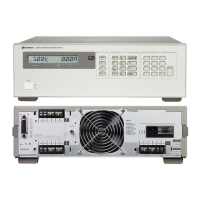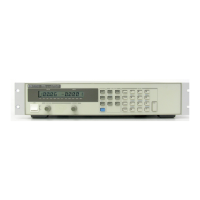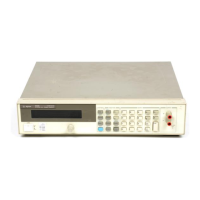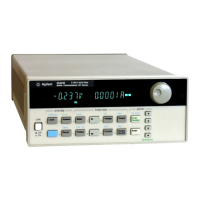Circuit compares the voltage at the current monitor resistor
with a reference and likewise varies the conduction of the
series regulator.
The interface circuit on the output board receives digital
signals from the GPIB board and converts them to analog
signals (reference voltages) which are sent to the control
circuit to program the output voltage and current.
The output boards can be commanded to send measurement
and status data back to the GPIB controller and/or to the
display on the front panel. The data is sent back via the
secondary interface circuit and the appropriate circuits on
the GPIB board.
The output board is able to sink current as well as source
current. Current sink limits are fixed at values slightly
higher than the maximum current source limit for the
particular output voltage operating point. See Figure 2-7 for
typical current source and sink characteristics. The output
board circuits are described in greater in paragraph 2-24.
2-7 GPIB BOARD (FIGURE 2-3)
Figure 2-3 illustrates the major circuits and signal flow on
the GPIB board. Complete circuit details are shown on the
functional schematic in the rear of this manual.
The functional names on the block diagram correspond with
those on the schematic so that the diagrams can be
correlated. As shown in Figure 2-3, the major circuits consist
of the GPIB interface, the system micro-computer, the
output boards interface, and the front panel interface circuit.
2-8 GPIB Interface
These circuits consist of the GPIB bus connector (J201),
transceivers (U203) for the 8 data lines and 8 control lines,
and the GPIB talker/listener chip (U202). All GPIB (IEEE-
488) functions are implemented by the GPIB chip which
handles data transfer between the microprocessor and the
GPIB, handshake protocol, and talker/listener addressing
procedures. The GPIB talker/listener chip is connected to
the data bus and appears as memory locations to the
microprocessor.
The eight data lines (DIO1-DIO8) of the GPIB are reserved
for the transfer of data and other messages in a byte serial,
bit parallel manner. Data and message transfer is
asynchronous, coordinated by the three handshake lines
(DAV, NRFD, and NDAC). The power supply can be a talker
or a listener on the GPIB. The controller dictates the role of
an GPIB device by setting the ATN (attention) line true and
sending talk or listen addresses on the data lines (DIO1-
DIO8). The power supply’s GPIB address is stored in the
EEPROM (electrically erasable programmable memory) chip
along with other system variables. You can find out your
supply’s GPIB address by using the front panel ADDR key
as described in the operating manual. As shipped from the
factory, the power supply’s address is set to 5. Any address
from 0 through 30 is a valid address.
There are five GPIB control lines: ATN, IFC, REN, SRQ, and
EOI (IEEE-488). When the controller sets the ATN line true,
all devices on the bus must “listen” to the addresses and
universal commands placed on the bus. When ATN is false,
only devices that are addressed will actively send or receive
data. All unaddressed devices will ignore the data lines
when ATN is false.
2-3
Artisan Scientific - Quality Instrumentation ... Guaranteed | (888) 88-SOURCE | www.artisan-scientific.com

